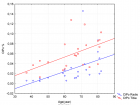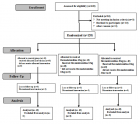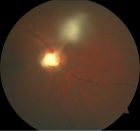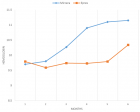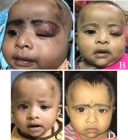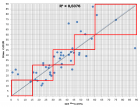Table of Contents
Assessment of early initiation of breastfeeding and determinants among mothers of children under 24 months in Southeast Ethiopia: a community-based cross-sectional study
Published on: 29th October, 2021
OCLC Number/Unique Identifier: 9323491709
Background: Early-initiation of breastfeeding is putting the newborns to the breast within the first hour of life. It is the first critical time they contact their mother outside of the womb. The current study aimed to assess the early initiation of breastfeeding in the study setting. Objectives: To assess the level of early initiation of breastfeeding and its associated factors among mothers who had a baby of less than the age of 24 months in Jeju Woreda, Arsi Zone, Oromia, Ethiopia, 2019.Methods: A community-based cross-sectional study conducted involving 487 mothers from September 18 to October 09, 2019. A multistage sampling technique was employed. First, the setting stratification done in urban and rural settings. Second, ten kebeles selected from both strata. The study participants identified by systematic random sampling technique using kebele log-books registration list as a scheme. The collected data were entered into Epi Info version 7.1.5.0 and exported to SPSS version 21.0.0.0 to analyze. Bivariate and multivariate logistic regression used to determine relations between independent factors and early initiation of breastfeeding. Nine variables became eligible for multivariate analysis at a p - value less than 0.05 in bivariate. The final analyses done the significance of association decided using AOR with its 95% CI, and p - value at less than 0.05. Results: A 97% response rate achieved in this study. The prevalence of early breastfeeding initiation was 74.5%. In multivariate analysis variables namely, mothers whose age category was 35 years and above (AOR = 2.34, 95% CI: (1.07, 5.11)), Pre-lacteal feeding (AOR = 0.37 95% CI (0.17, 0.79)), postpartum advice (AOR = 1.72, 95% CI (1.01, 2.95)) had a significant association. Conclusion and recommendations: The prevalence of early breastfeeding initiation was (74.5%). The finding was low compared to the world health organization recommendation. A working towards discouraging pre-lacteal feeding and strengthening postnatal advice and focusing on ways to better reach young mothers were the recommendations to bring the prevalence in the study area to the recommended level.
A case report: Electrochemical impedance spectroscopy as an Al-ternative for cell counting chambers of yeast (Saccharomyces cerevisiae) for brewery applications
Published on: 26th April, 2021
OCLC Number/Unique Identifier: 9026744815
Advanced technologies, such as electrochemical impedance spectroscopy (EIS), are a valuable tool which can enhance and simplify the industrial process monitoring if used correctly. State-of-the-art approaches for screening the cell growth of for example yeast during the brewing process still heavily rely on offline methods such as methylene blue or florescence dye-based staining, and/or the usage of flow cytometric measurements. These methods, while being accurate, are very time consuming and require heavy manual effort. Furthermore, the time span needed to obtain the counting result can lead to a time-delayed response signal and can impact the quality of the final product. In recent studies, applications of low-frequency EIS in the α-regime were used for the determination of cell counts and the metabolic state in Saccharomyces cerevisiae. This method has proven to be a reliable tool which has also shown high potential in industrial scale applications. The online biomass monitoring, as well as viable cell count, for feasibility study was performed in-house at Stiegl Brewery in Salzburg/Austria founded in 1492.
Mild to moderate iodine deficiency in pregnancy: A matter of debate
Published on: 12th March, 2021
OCLC Number/Unique Identifier: 8980359493
During the last few decades painstaking efforts have been made to eliminate iodine deficiency through the world. Nowadays in regions where dietary iodine intake is adequate or borderline, the main focus is increasing dietary iodine supply in the target population during pregnancy and the first years of life. Severe iodine deficiency during pregnancy increases the risk of irreversible brain damage, intellectual disability, neurologic abnormalities, stunted growth, increased pregnancy loss, infant mortality, impairments in child development and cretinism. The potential effects of mild-to-moderate iodine deficiency are debated. Results from animal studies and observational human studies indicate that maternal mild-to-moderate iodine deficiency disturbs thyroid function in pregnancy and it also may affects fetal neurodevelopment. The effect of supplementation of iodine on thyroid function of pregnant women and their newborn, neurodevelopment of infants and cognitive performance of children have been investigated using iodine nutrition in pregnancy, based on median urinary iodine concentration. However they have found conflicting results regarding the benefits or harms of iodine supplementation in pregnancy. Although many epidemiological, interventional and clinical studies have supported the association between thyroid function in pregnant women and later psychomotor and mental development of their children, the effect of iodine supplementation in pregnant women on neurodevelopment of children is inconclusive. Even in areas with well-established universal salt iodization program, pregnancy could be at risk of having iodine deficiency and despite WHO/ICCIDD/UNICEF recommendation which believe that dietary iodine fortification during pregnancy depends primarily on the extent of pre-existing iodine deprivation, systematic dietary fortification needs to be implemented in this vulnerable group. However, iodine supplementation of mildly iodine deficient pregnant women may not have beneficial effects in their thyroid function or neurodevelopment of their children.
Risk of developing eating disorders through the misperception of the body image and the adoption of bad eating habits in a sample of young volleyball athletes
Published on: 8th March, 2021
OCLC Number/Unique Identifier: 8980363455
Objective: This preliminary study focused on the description of some dysfunctional perceptions of the body image and eating habits in a sample of young.
Methods: The results obtained by 55 amateur and professional volleyball players belonging to volleyball sports clubs located in the province of Reggio Emilia were examined. The age of the sample is in a range between 11 and 44 years. The participants completed the Pisa Survey for Eating Disorders (PSED), a questionnaire aimed at examining eating behavior and the perception of one’s body image. The athletes’ height and body weight were subsequently detected through direct measurement.
Conclusion: The data collected through the self-evaluation questionnaire and the measurements carried out by the study made it possible to analyze the perception of the body image and the eating habits of the volleyball players belonging to the sample and to compare them with the data in the literature. The data, albeit preliminary, allow us to confirm the existence of the discrepancy between the real body image and the desired one, in a group of young athletes, who favors the adoption of non-adaptive coping strategies to control one’s own weight and body shapes typical of the vicious circle - strict diet, bingeing episodes, compensatory behaviors - which characterizes eating disorders (ED). It is therefore considered essential that body image assessment is a practice implemented in the assessment routine of these athletes, especially in consideration of the fact that body image disturbance is a very common feature in this category and is one of the main risk factors of EDs.
Iodine status and thyroid parameters of pregnant women living in an iodine sufficient area
Published on: 3rd February, 2021
OCLC Number/Unique Identifier: 8980371650
During the last few decades painstaking efforts have been made to eliminate iodine deficiency throughout the world. Todays in regions where dietary iodine intake is adequate or borderline, the main focus is increasing dietary iodine supply in the target population during pregnancy and the first years of life.
Objective: The aim of this study was to obtain longitudinal data on urinary iodine excretion and the changes of maternal thyroid parameters in two groups of healthy women with mild-to-moderate iodine deficiency and iodine sufficiency residing in an iodine replete area of Tehran capital city of IR Iran, for more than one decade.
Research designs and methods: The present study is part of a cohort study, investigating the relative influences of iodine intake on thyroid size and function of mothers and their infants during and after pregnancy. A total of 500 pregnant women enrolled from two mother-child health care centers and was divided into group I, with median urinary iodine excretion (MUIE) < 150 µg/L, and group II with MUIE ≥ 150 µg/L. Sonographic thyroid volume measurement, urinary iodine excretion and thyroid function tests were measured sequentially in all pregnant women during the three trimesters (T) of pregnancy.
Results: The mean ± SD age of the participants was 25.1 ± 5.1 years. The MUIE in group I and II in the first, second and third trimester were 123 and 250 µg/L, 127 and 166 µg/L, 120 and 150 µg/L, respectively. The MUIE in the third trimester of pregnancy in group I did not differ significantly from the values in the first and second trimesters (p = 0.67), but it did decline significantly in group II (p < 0.001). The median thyroid volume of subjects, in the first, second and third trimesters were 7.8, 8.2 and 8.1 ml in group I and 7.5, 8.0 and 8.4 ml in group II, respectively. No difference in thyroid volume was found between two groups in each of the three trimesters of pregnancy (p > 0.05). The mean (± SD) TSH concentration of subjects in first, second and third trimester was 2.3(± 2.6), 2.1(± 1.8), 2.3(± 1.7) mIU/L in group I and 2.1(± 3.1), 2.1(± 1.8) and 2.0(± 1.3) mIU/L in group II, respectively. The trend of TSH rising in group I was 26.7% and in group II it was 13.3%. The mean TSH value in three trimesters did not differ significantly in either groups (p > 0.05). The mean (± SD) total T4 concentrations of subjects in first, second and third trimesters were 13.2(± 3.4), 13.8(± 3.3), 13.0(± 2.9) µg/dl in group I and 13.1(± 3.2), 13.7(± 2.9), 13.4(± 3.2) µg/dl in group II, respectively. The mean total T4 value in three trimesters did not differ significantly in either groups (p > 0.05). There was no correlation between the thyroid volume and three observed parameters (UIE, total T4 and TSH) during the pregnancy in either groups.
Conclusion: Even in areas with well-established universal salt iodization program, pregnancy could be a risk of having iodine deficiency and systematic dietary fortification needs to be implemented in this vulnerable group.

HSPI: We're glad you're here. Please click "create a new Query" if you are a new visitor to our website and need further information from us.
If you are already a member of our network and need to keep track of any developments regarding a question you have already submitted, click "take me to my Query."






